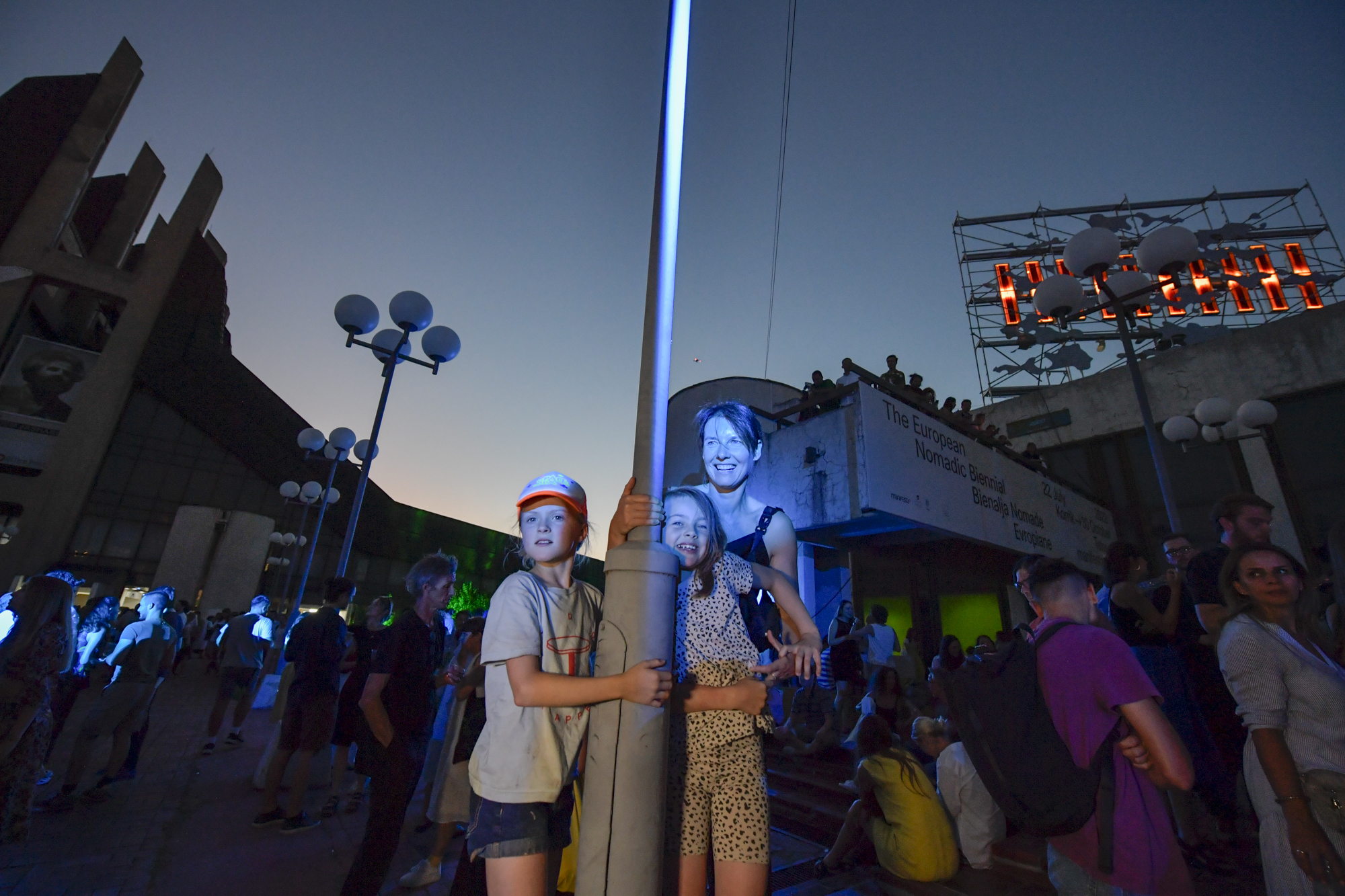
As Manifesta packs its bags for Barcelona, the debate on its legacy unfolds in Kosovo.
Walking through the central square of Prishtina, across from the Assembly building, your eye catches something out of place. A yellow house sits atop what used to be the Gërmia Department Store, today the offices of the Tax Administration of Kosovo. You rub your eyes in disbelief. It’s outrageous, the audacity. “Here too?” you think angrily, grabbing your phone to call the police.
“Someone built an illegal house, right in the center. Do something!”
The house was not one of the many illegal constructions across Prishtina, it is the most recent work of contemporary artist Alban Muja (who reports that some residents did indeed call the police to report what they assumed was an illegal rooftop structure).
Muja’s rooftop installation was part of the 14th edition of the nomadic Manifesta Biennial, which opened in Prishtina on July 22 and closed October 30. Over the last nearly three decades, Manifesta has traveled everywhere from Spain to St. Petersburg. Barring an early edition in Ljubljana, Manifesta 14 represents the first time the biennial has come to the Balkans.
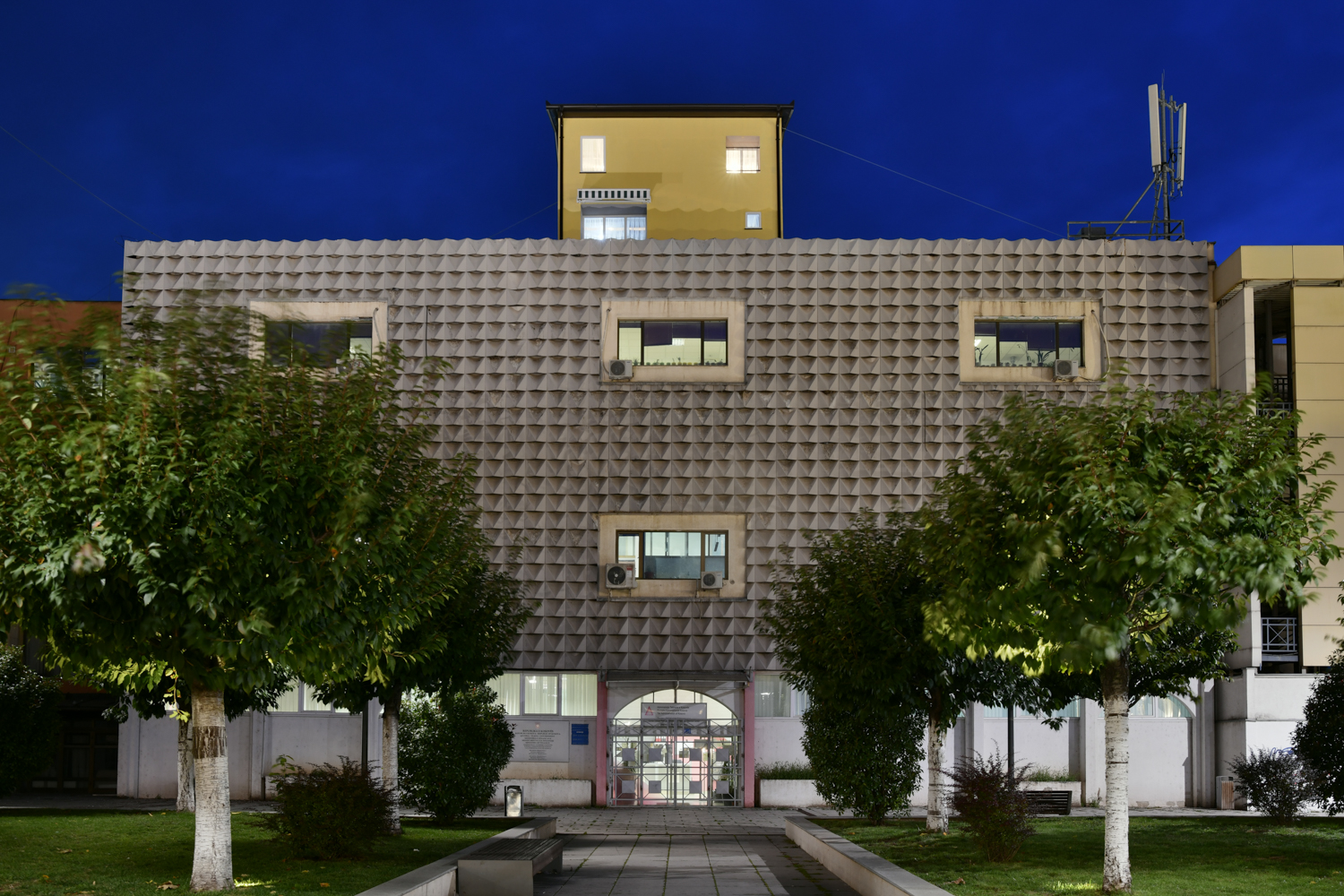
Photo: © Manifesta 14 Prishtina | Atdhe Mulla.
With the promise to help Kosovars reclaim public space and to “tell stories otherwise,” the biennial set itself the task of engaging with some of Prishtina’s most emblematic sites, many of which have suffered from institutional neglect — so much so that it was conceivable to some that an illegal house could be built on the roof of the tax administration building.
Now with Manifesta on the way out the door, Prishtina reflects on what Manifesta was and what it leaves behind.
Kosovo has never featured more prominently in the international art world and an international cultural event of this scale has never before taken place in the country. Local and regional artists had the chance to present and connect with the rest of the world and there was a reinvigoration of attempts to revitalize the city’s neglected public spaces and historical legacy.
But the bright lights of the biennial cast shadows too. A number of the proposed transformations have been lackluster or went unfulfilled while many local non-profit cultural organizations balked at the seemingly endless public funding and state support offered to the biennial while they struggle to scrap together basic funding. Local organizations, many of which are engaged in preserving the sites Manifesta engaged with, are left wondering if the support Kosovo’s institutions gave to the biennial will be extended to them in the coming years.
Reclaiming public space
The large windows of Driton Selmani’s art studio overlook the Rilindja building, one of Prishtina’s brutalist architecture icons from the ’70s. Originally named the Rilindja Press Palace, for more than 20 years the building was the hub of Kosovo’s literary and cultural life, housing a number of socially-owned enterprises including the renowned newspaper Rilindja and its associated publishing house. “I grew up following the Rilindja logo in every publication,” Selmani said. “The concrete walls of what’s left from the printing house building just fascinate me.”
Selmani was one of 103 artists who participated in Manifesta 14, 65 of whom were from the Western Balkans and approximately 40 of whom were from Kosovo. The high percentage of regional artists distinguished this year’s biennial as “radically local,” in the words of the organizers.
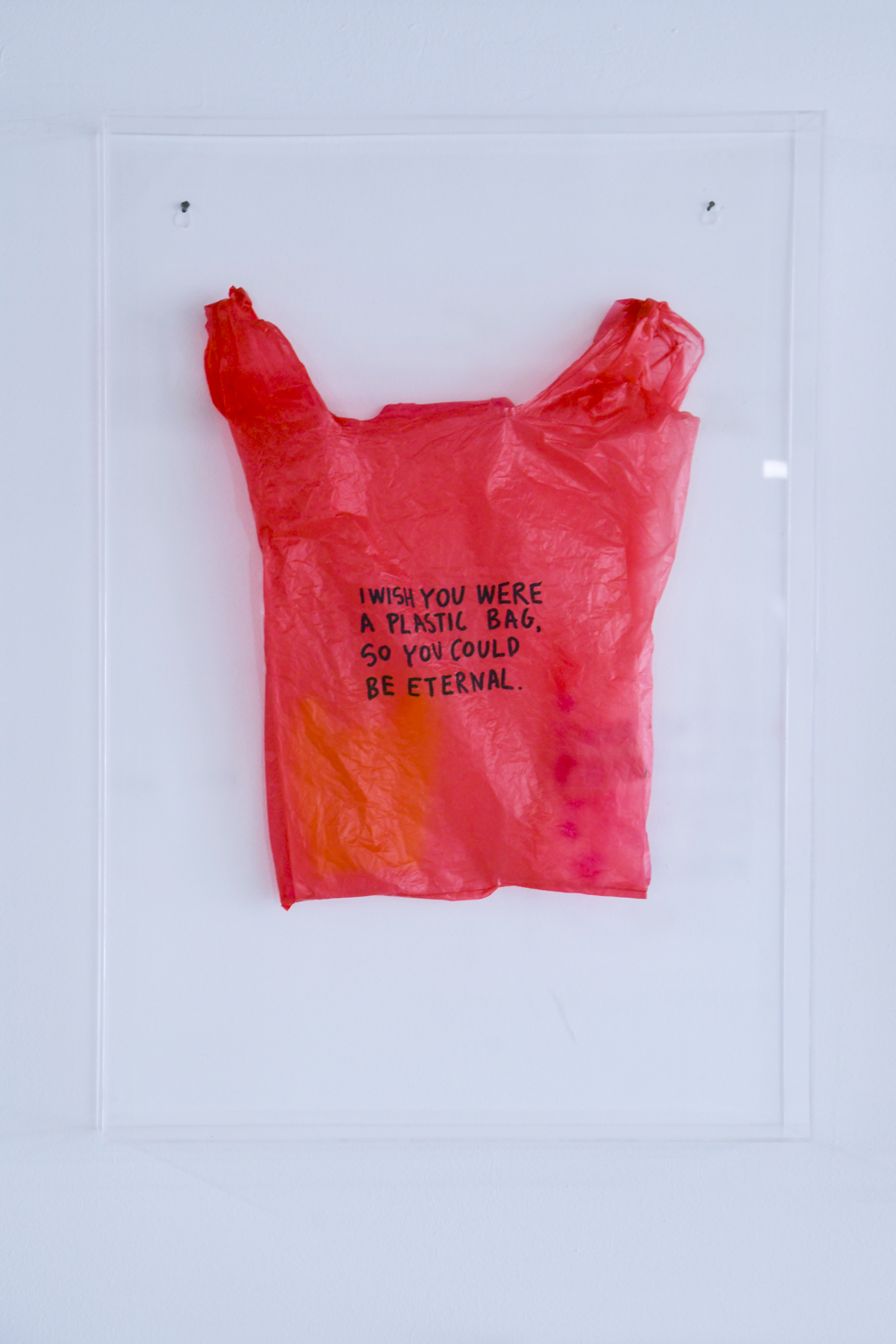
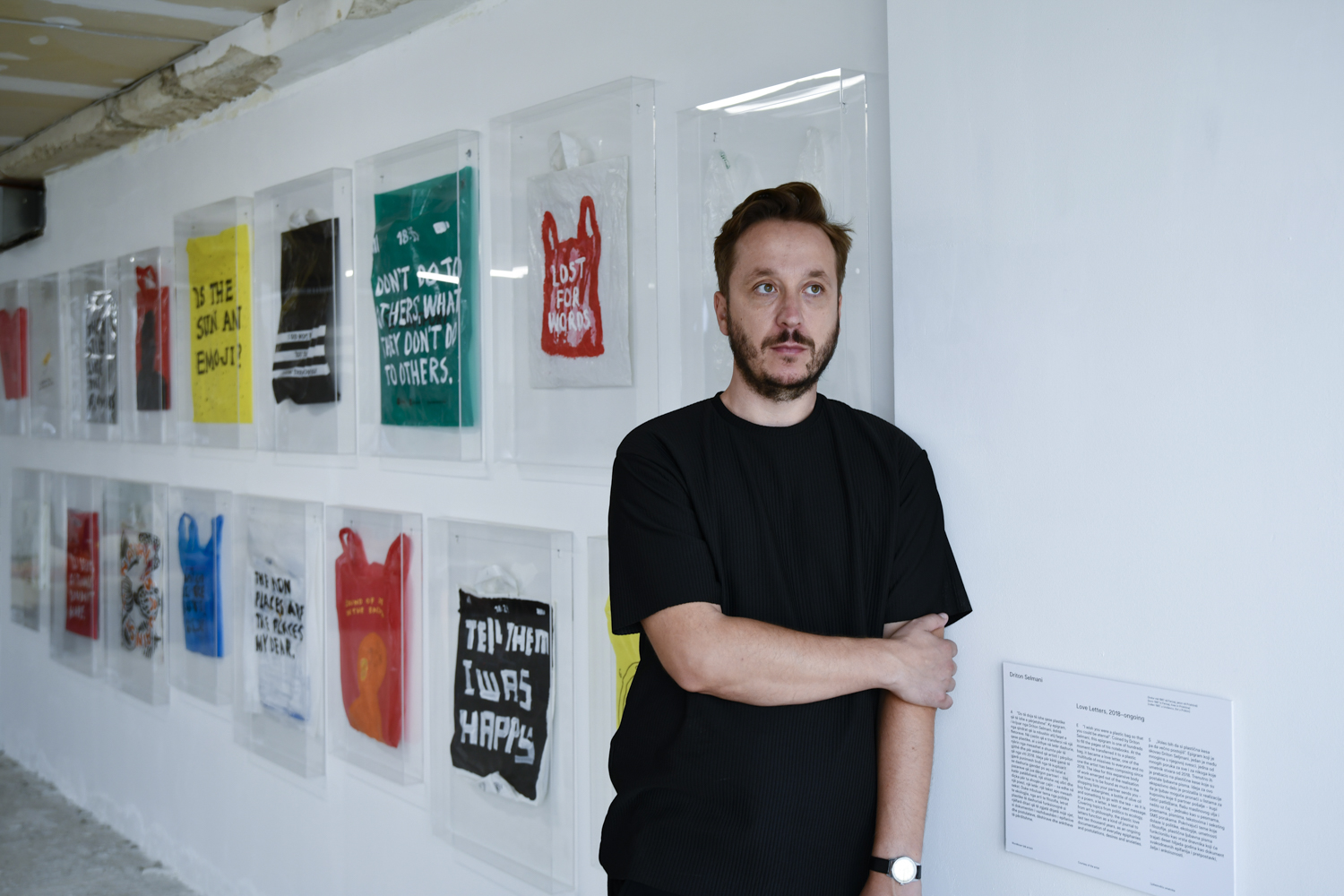
Photos: Atdhe Mulla / K2.0.
Selmani’s work “Love Letters” was exhibited on the seventh floor of the Grand Hotel Prishtina. An ongoing project since 2018, the work consists of short phrases painted on plastic bags, which, he says, reflect how “love can take the shape of shopping lists and plastic bags filled with supermarket items.”
The Grand Hotel and Rilindja were two of the 25 venues on Manifesta’s distinctive green and purple map that took visitors on a guided tour of the city’s past and its future promise. It wasn’t just visitors who traversed the city map in hand. “For the first time in my life, I walked with a map in my own city,” said Selmani. “Having different cultural destinations to visit in a city is something I’ve always coveted and I felt I had the chance to do that in Prishtina during the last three months.”
The artistic core of the biennial was in the center of the city at the Grand Hotel where visitors could visit seven floors of art and look out on the heart of Prishtina from new heights and perspectives. The rooftop was transformed with an attention-grabbing intervention by Kosovar artist Petrit Halilaj who replaced the hotel’s signage with his own that read in Albanian “when the sun goes away, we paint the sky.”
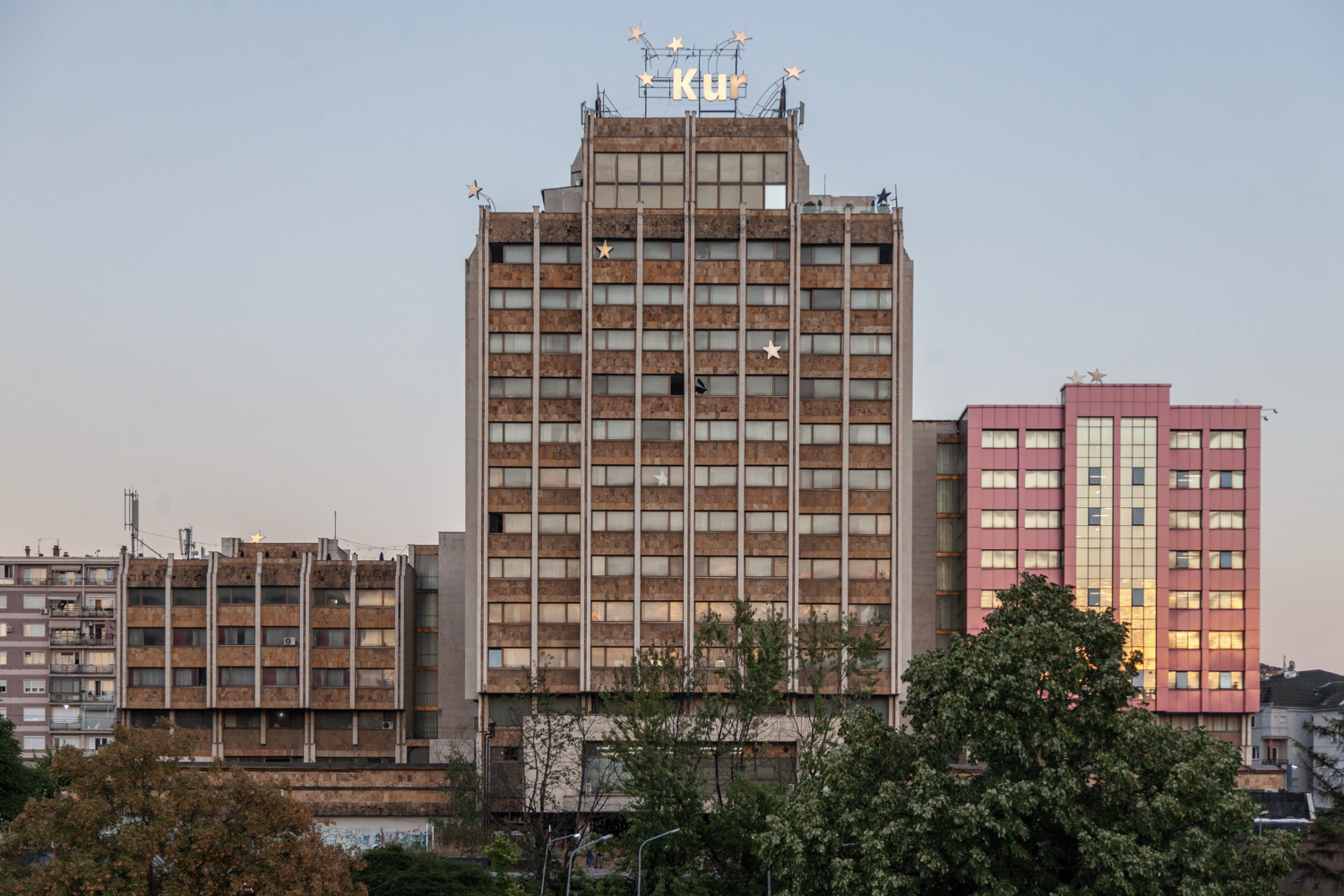
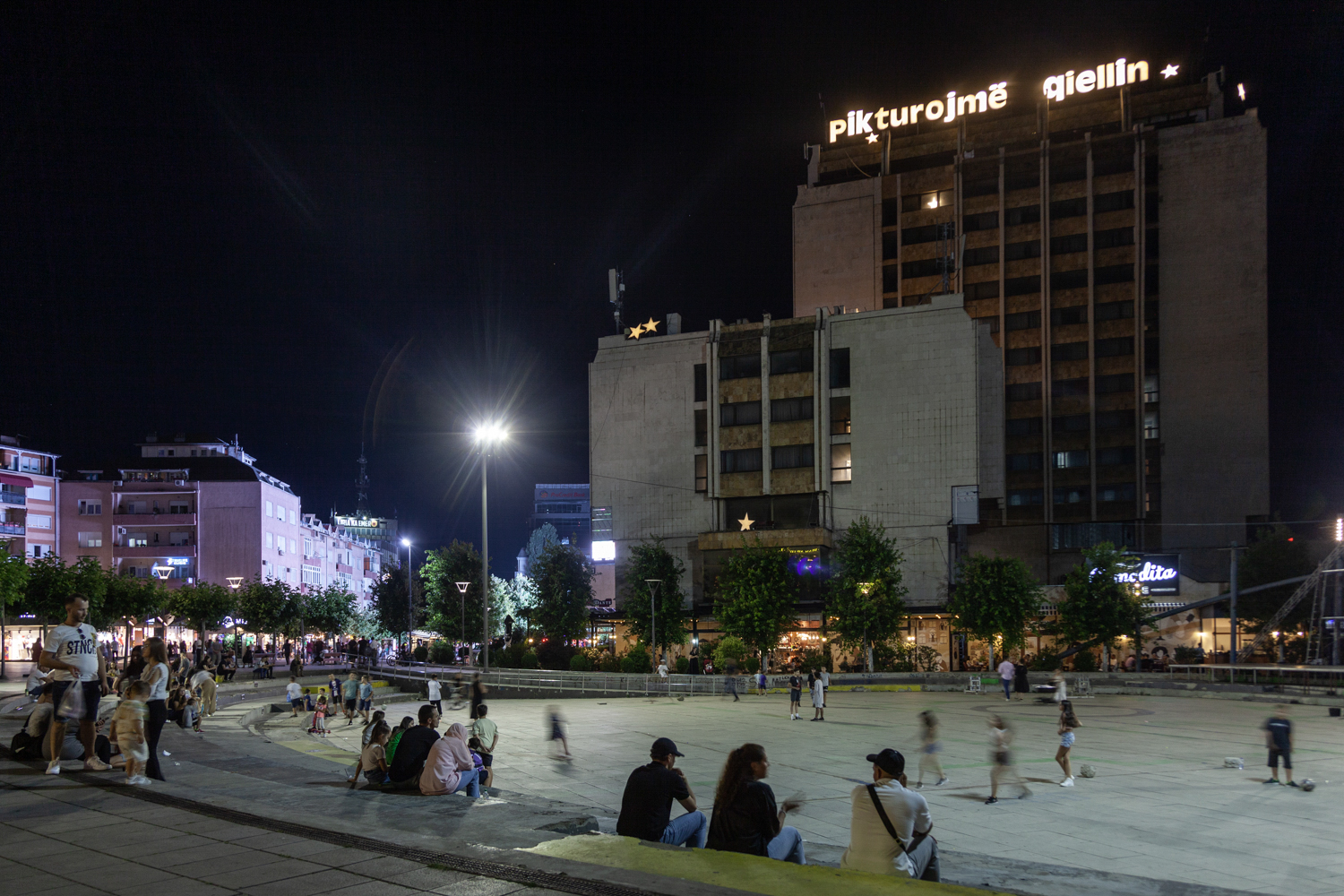
Photos: © Manifesta 14 Prishtina | Majlinda Hoxha.
Titled “The Grand Scheme of Things,” the exhibition inside the hotel took a landmark of the city that has been mired in controversy and debts and filled it with dozens of works from international and local artists.
Built in 1978, the Grand Hotel at its peak was a symbol of modernity and sophistication for the city. By the ’90s, it became one of the many public spaces from which Albanians were excluded. Its decline quickened after the war as it went through a particularly unsuccessful privatization process, eventually winding back in the ownership of the Privatization Agency of Kosovo (PAK). With an unsettled future and a troubled past, the Grand Hotel has long been largely empty.
The Grand Hotel’s seven floors of instagrammable art were Manifesta’s main attraction, but the biggest transformation facilitated by the biennial was the building that used to house the Hivzi Sylejmani Library. A monument of cultural heritage under temporary protection, the 1930 building was the home of the city library for almost 70 years.
Located in one of Prishtina’s oldest neighborhoods, the building was a gathering place and event space for the community until 2016 when the library moved into new premises. The building had been closed until Manifesta turned it into the Center for Narrative Practice (CNP), an interdisciplinary cultural institution that housed the biennial’s educational program, featuring workshops, literary events and musical performances. (Co-author of this article Lirika Demiri contributed to a Manifesta-funded research project related to the Library. Co-author Aulonë Kadriu led a children’s education workshop for Manifesta.)
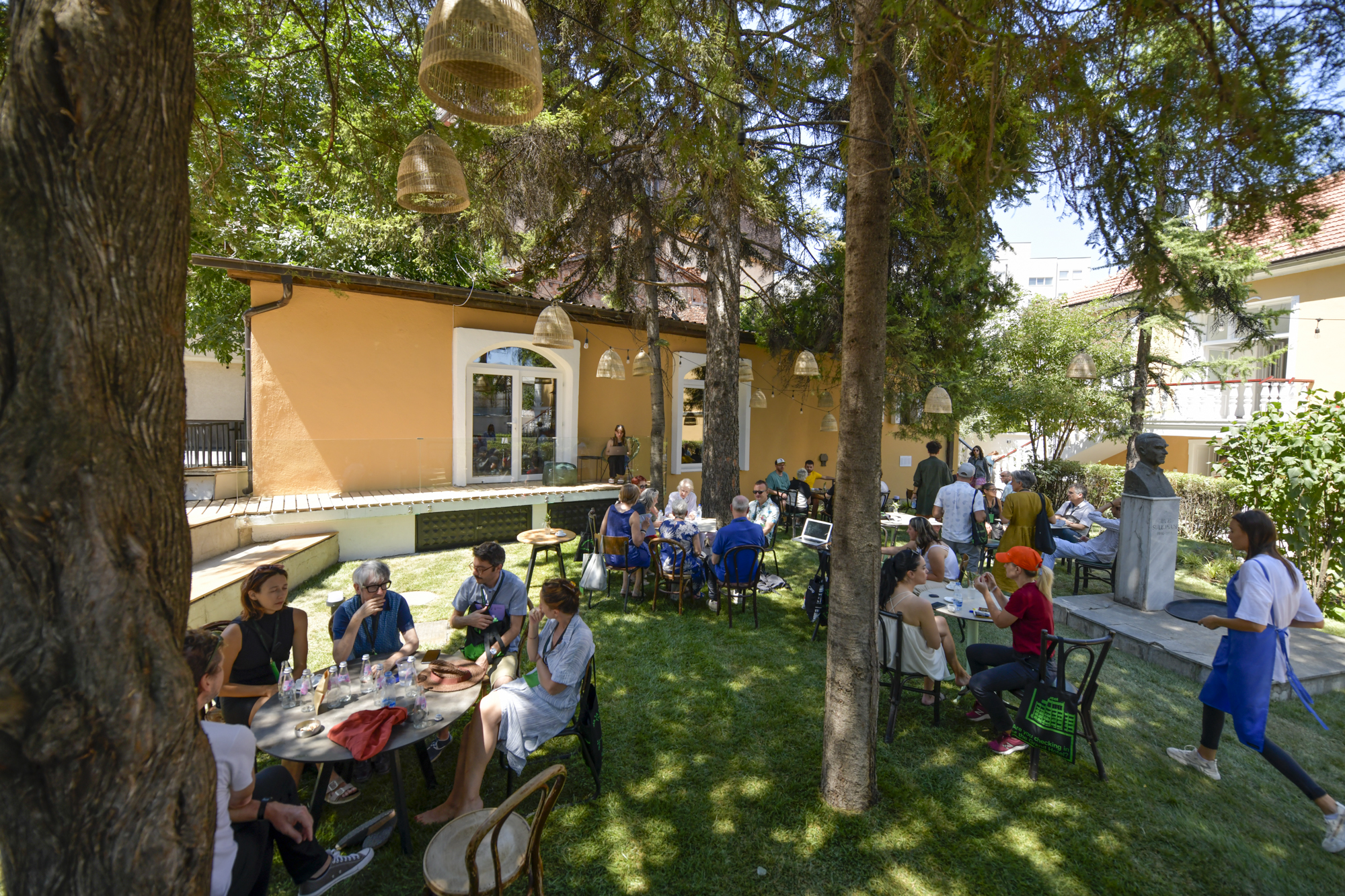
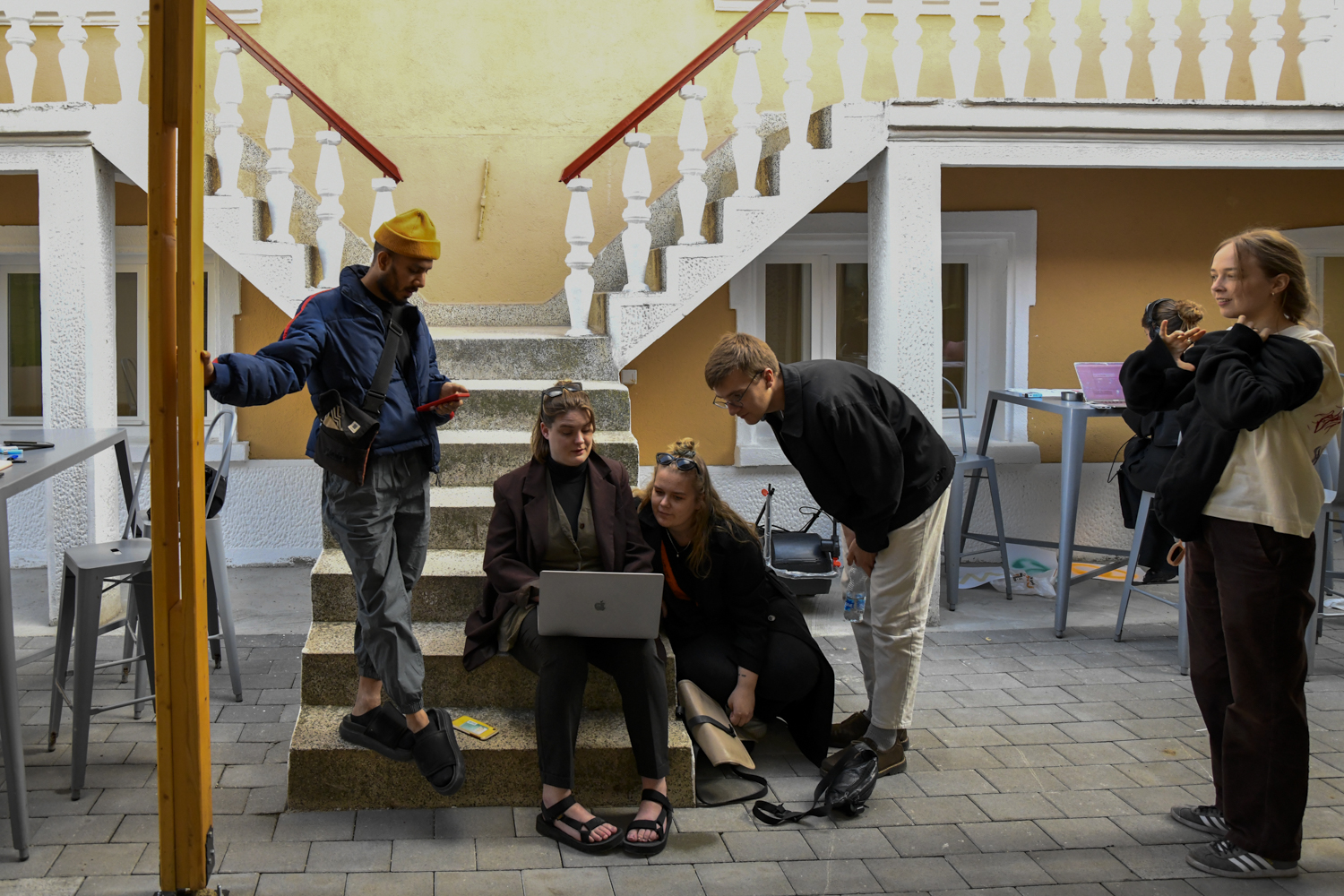
Photos: © Manifesta 14 Prishtina | Atdhe Mulla.
Another unused space taken over by Manifesta 14 was the Brick Factory. The long-abandoned building was privatized after the war before the Municipality of Prishtina bought it from PAK. Consecutive governments have made unfulfilled promises to revive it. There was once talk of a Genocide Remembrance Museum and then more recent electoral promises to turn it into a digital center and combined cultural scientific space for youth. Instead, it has languished for years as an illegal dumping ground.
Manifesta 14 sought to turn the site into an eco-urban learning center and invited raumlaborberlin, a German collective of architects and urbanists, to transform the space, which was cleaned up and used for events during the biennial.
On the way to the Brick Factory, your map may have taken you through a segment of abandoned train tracks that Manifesta 14 promised to reimagine as the “Green Corridor,” following the urban vision of the design studio CRA-Carlo Ratti Associati. The intervention consisted of a yellow 1,300-meter wooden pedestrian path along the tracks that divide the Arbëria neighborhood from the city center.
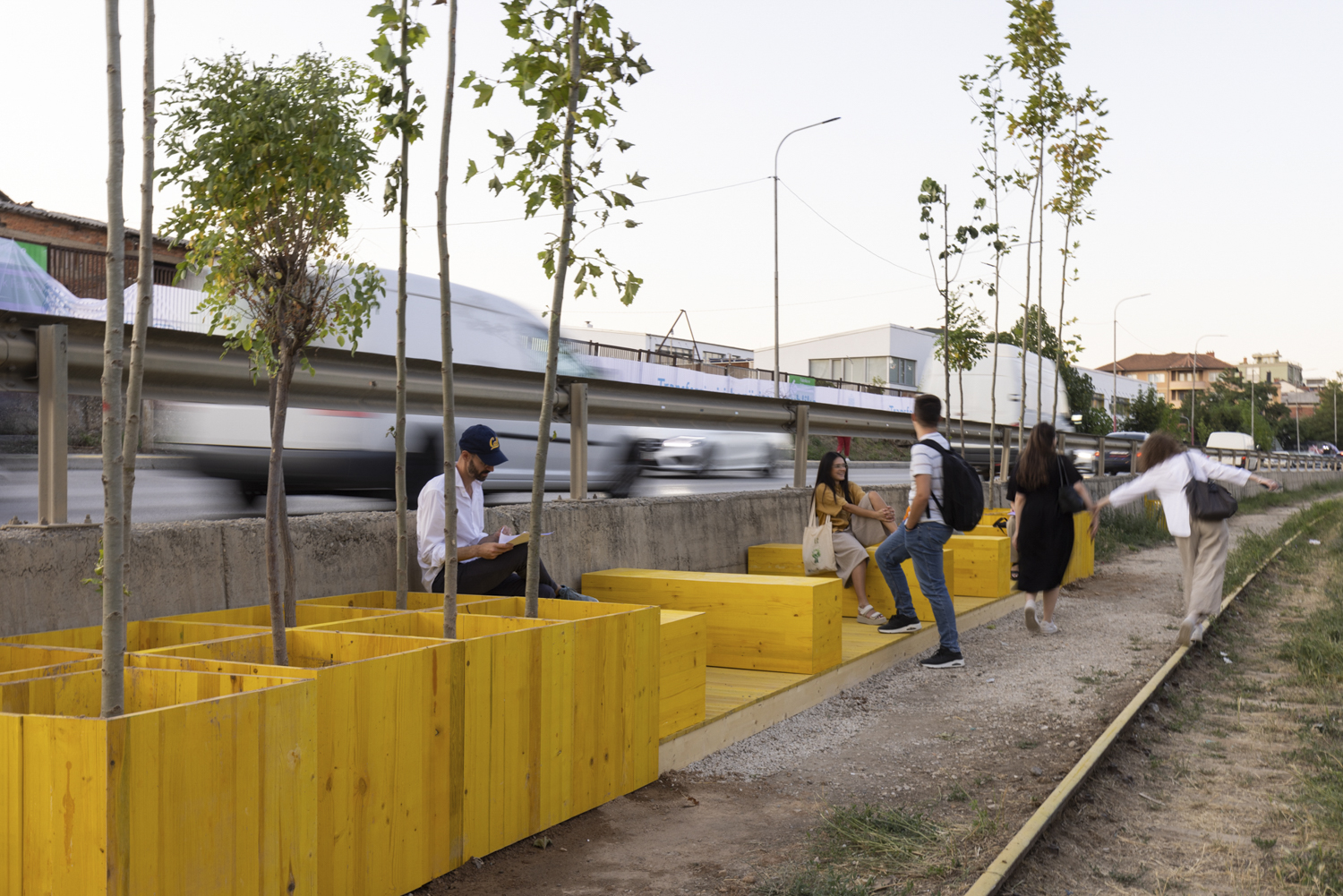
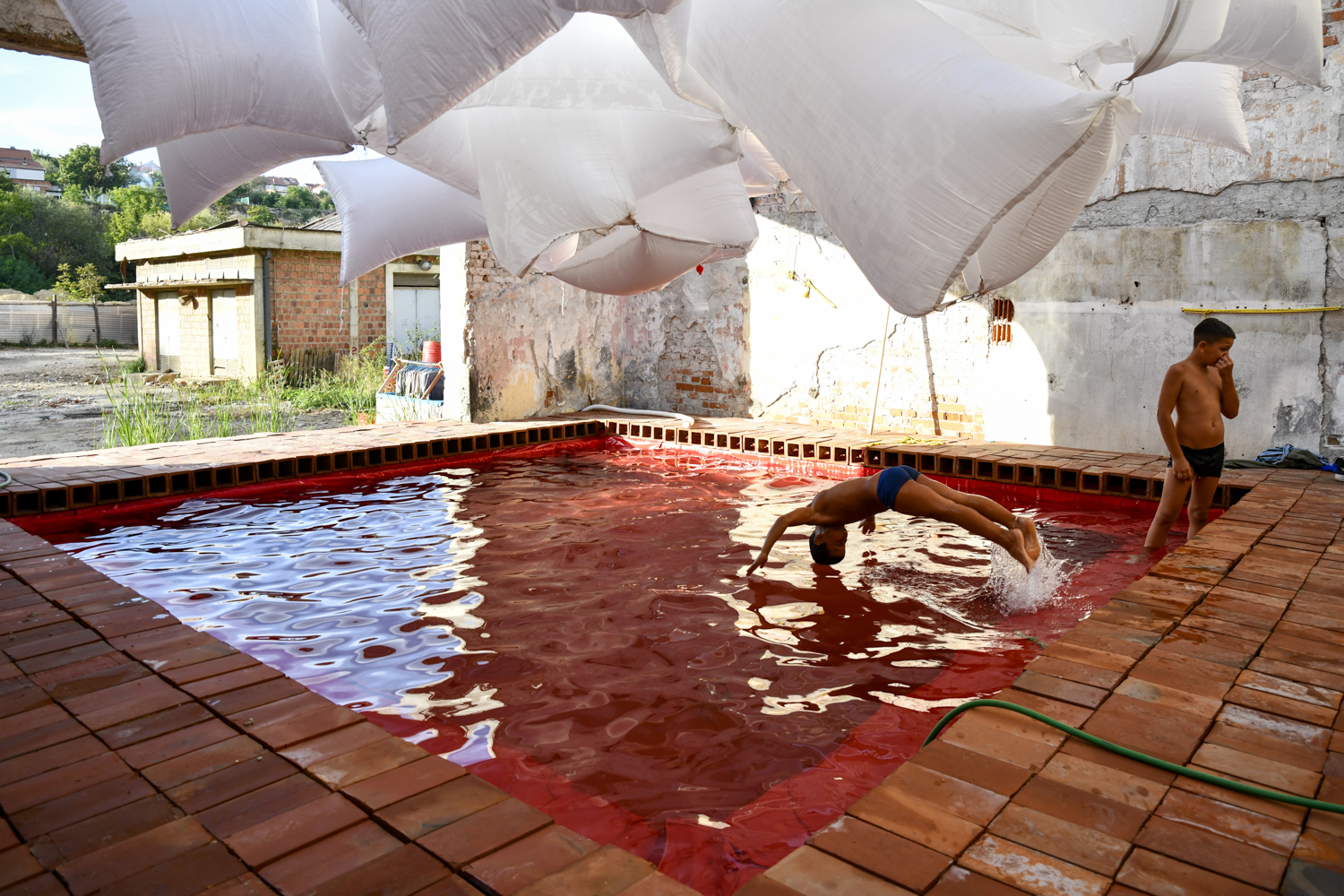
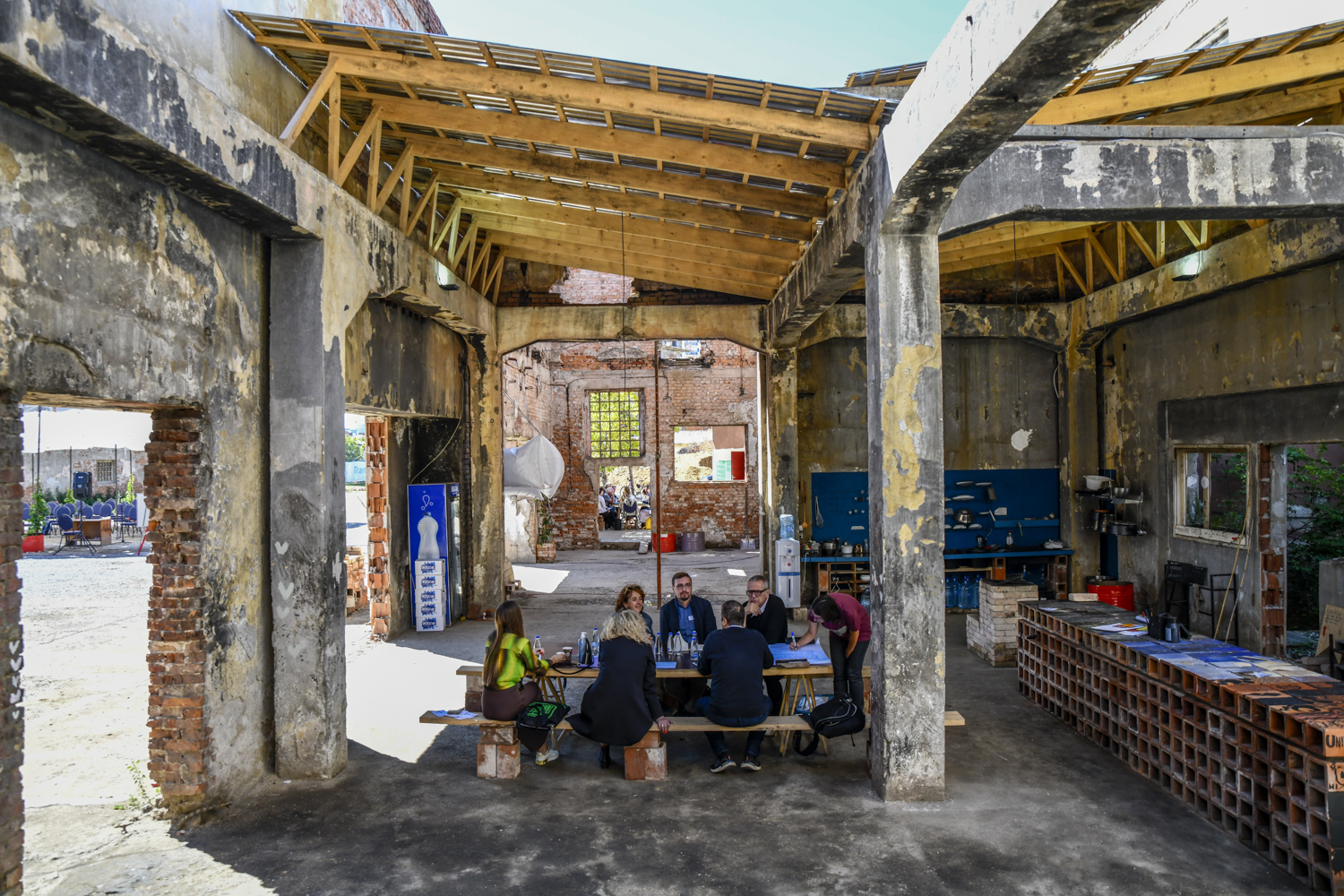
Photo: © Manifesta 14 Prishtina | Atdhe Mulla.
For Arbëria’s residents, the daily routine of having to walk through improvised paths — muddy on rainy days and dusty in summer — to reach the city center is an almost Sisyphean activity. The Green Corridor aimed to create a more accessible, greener and safer space for pedestrians and to change their relationship to that slice of the city.
At the close of the biennial, the eye-catching yellow had already started to fade, some of the new trees didn’t survive the summer and the path does not seem to have attracted many residents. According to Manifesta 14, the Municipality of Prishtina will continue developing the project for the next seven years in close collaboration with UN-Habitat, a United Nations urbanism program.
Green painted dots across the city led to Manifesta venues. One set led to another neglected space turned into an exhibition: the Great Hammam. Built in the 15th century, the hammam is one of the dwindling few remnants of Ottoman architecture in the city. No longer a vibrant locale of social bathes, the space has been crumbling for decades.
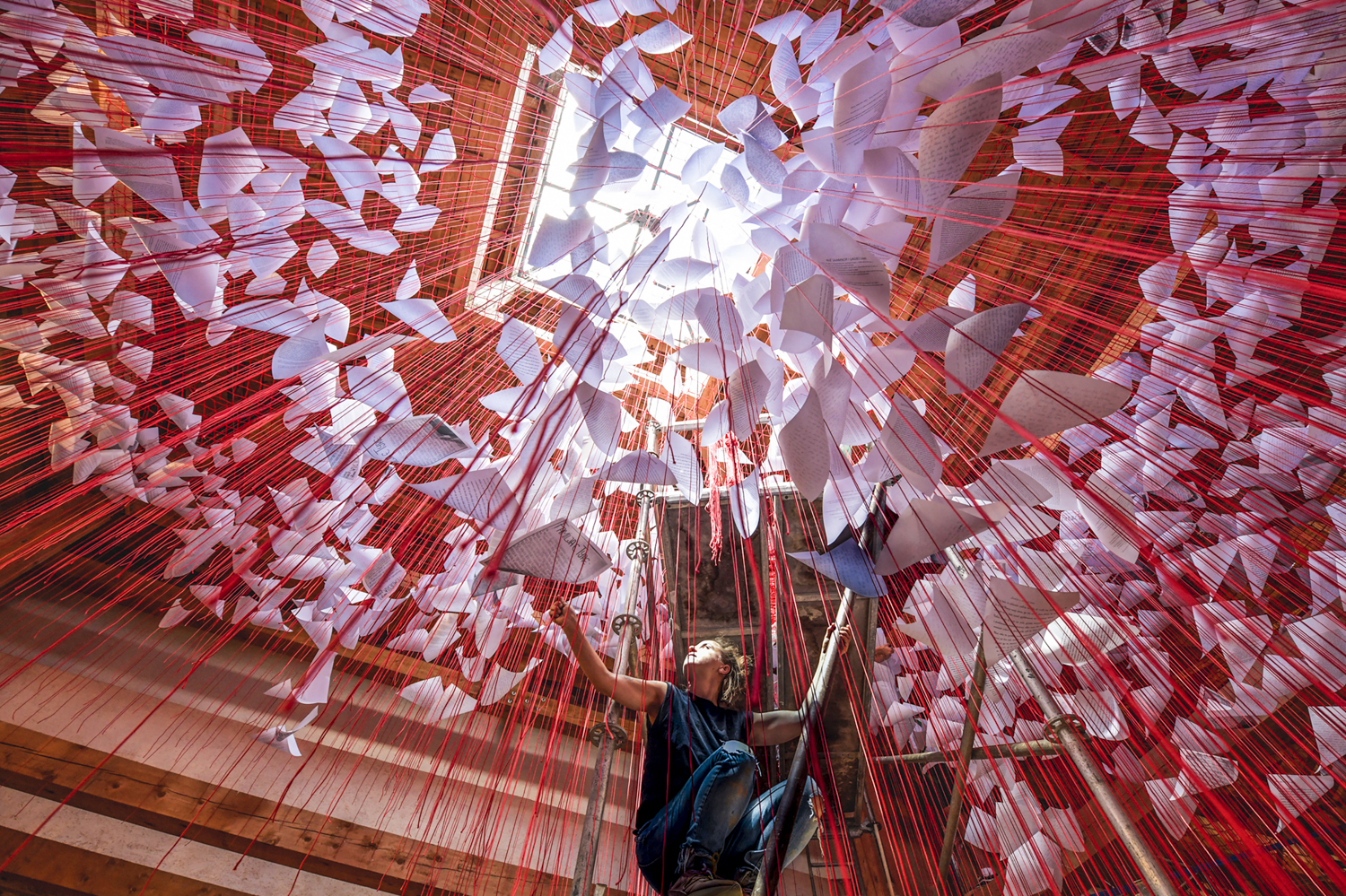
Photo: © Manifesta 14 Prishtina | Atdhe Mulla.
Inside the hammam was “Tell me your story,” a work by artist Chiharu Shiota that consisted of pieces of paper with personal stories written on them, all hanging from red yarn tied to the rafters. The eye-catching installation attracted everyone from teens looking for a pretty backdrop for an Instagram photo to politicians giving press conferences, potentially instilling in the people of Prishtina the possibility this overlooked space still holds.
The old problems remain
One of Prishtina’s most visually distinctive buildings, The Palace of Youth and Sports, was Manifesta’s temporary home base and also the place where the biennial kicked off back in August. Housing interventions by Flaka Haliti, Lee Bul and Astrit Ismaili, Manifesta re-injected some of the youth culture spirit that has been largely missing for the past decades and drew the President, Prime Minister and Mayor to the opening event along with hundreds of people.
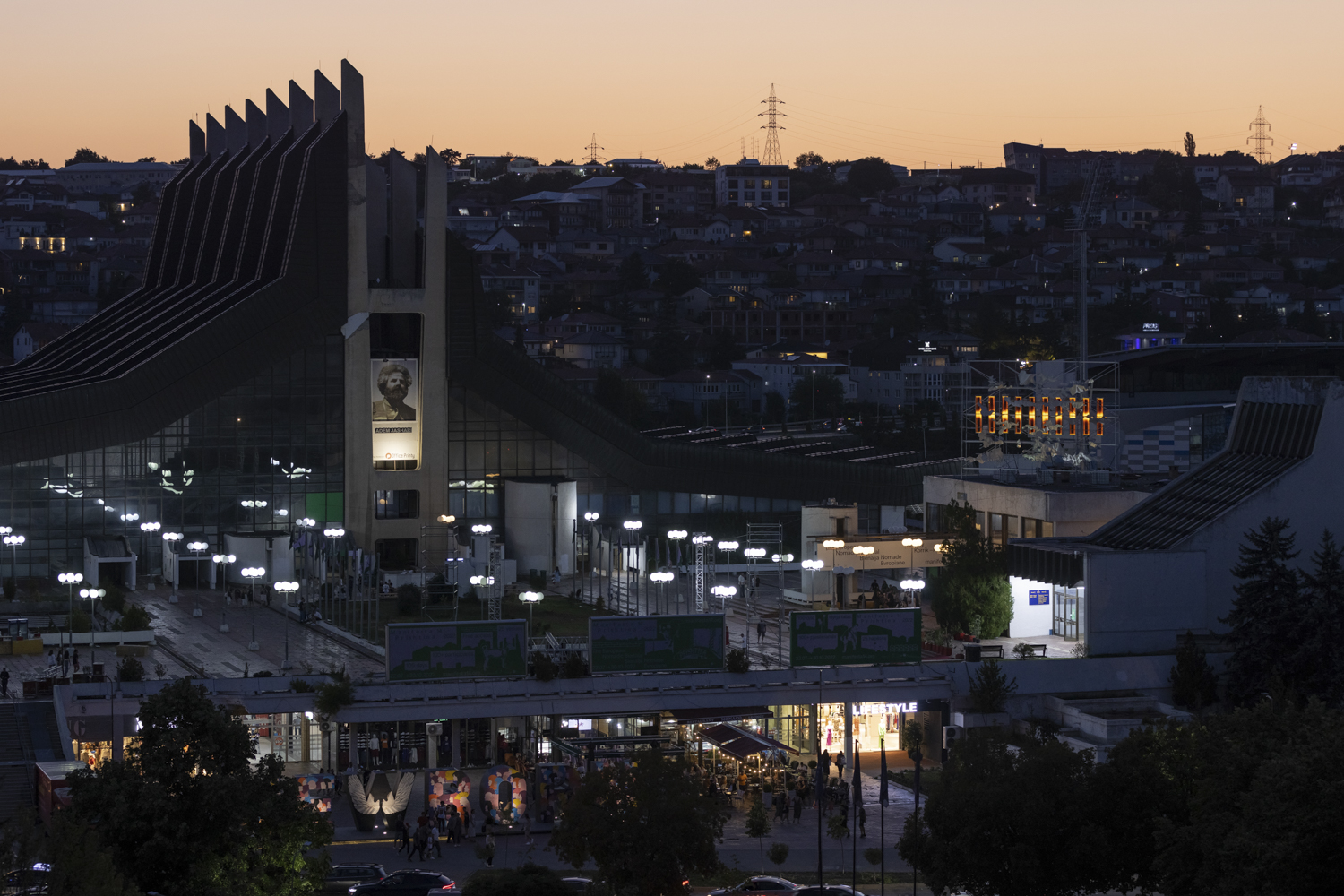
But the building has not always enjoyed the attention of Kosovo’s leadership. Similar to many buildings where Manifesta hosted events and exhibitions, the Palace has been under PAK and then Municipal ownership, and years of promises to restore aging infrastructure have long gone unfulfilled.
Though the red carpet was rolled out for Manifesta, the Oda Theatre, which has been housed in the Palace since 2003, has been complaining about upkeep, heating, insulation and safety issues for years. Though a call for renovation designs for the non-profit theater organization’s facilities was announced in 2021, no steps have been taken. When K2.0 contacted the Municipality to ask about the plan they said, “We are very busy with Manifesta.”
This has left local cultural organizations feeling neglected. Playwright Jeton Neziraj, director of the non-profit cultural organization Qendra Multimedia, which shares space with the Oda Theatre, is critical of the “hostile circumstances” local organizations face in comparison with the open-handed government support offered to Manifesta. While Oda and Qendra Multimedia are housed in a basement of the Palace and face serious infrastructural problems, Neziraj said, the “internationals,” that is, Manifesta, were granted comfortable offices above.
Manifesta 14 found Kosovo’s arts and culture sector grappling with systemic problems that have been accumulating over the past two decades, with independent cultural organizations facing unstable financial support, a lack of work space and rigid bureaucratic hurdles to access public funds.
The organizers of the biennial have estimated the total budget of this year’s biennial at roughly 6 million euros, out of which 69% was paid for with public funds from Kosovo; the Municipality of Prishtina and the Ministry of Culture, Youth and Sport were the main contributors. Prishtina’s municipal Directorate of Culture has repeatedly declined to provide K2.0 with a more detailed budget of what they allocated to Manifesta and how it was spent, citing the need to wait for final reports after Manifesta ends.
In a local podcast, Vesa Sahatçiu, former advisor to Prishtina’s mayor and former Manifesta 14 board member, stated that the Municipality provided around 2 million euros to the biennial. The Ministry of Culture told K2.0 in an email that it allocated 1,971,881 euros to Manifesta.
Public funding for Manifesta faced some backlash after details emerged of two dinner bills, totaling over 5,000 euros, that the city paid for international guests. The Municipality responded to the furor saying that the expenses were in accordance with city regulations.
The news was particularly galling to Jeton Neziraj. “The generous relationship of the state with Manifesta 14 was a hypocrisy, considering how the local cultural scene has been marginalized and neglected for years,” he said.
In 2021, Qendra Multimedia was allocated 5,000 euros from the Ministry of Culture for their annual Polip International Literary Festival. In a caustic Facebook post, Qendra Multimedia rejected the funding, describing it as paltry and insufficient, and suggested sarcastically that the Ministry give it all to Manifesta. This type of frustration about the biennial from cultural figures is widespread, though few voice it openly.
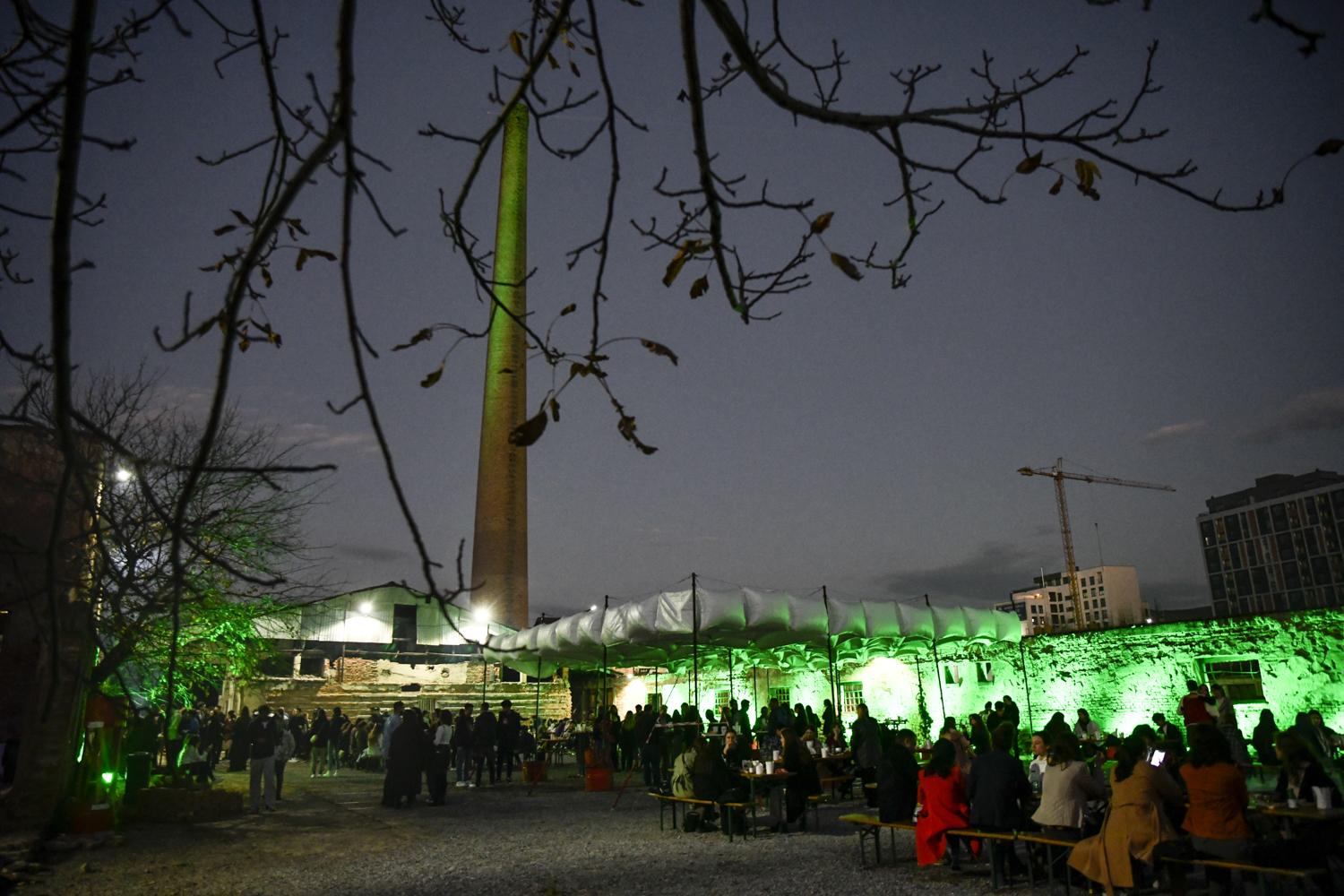
Photo: © Manifesta 14 Prishtina | Atdhe Mulla.
Veton Nurkollari, the artistic director of Prizren’s international film festival Dokufest, had similar concerns. In an interview with K2.0 in August, he said that the state’s massive financial support for Manifesta 14 showed what can be done for cultural events in Kosovo. But he also noted his frustration that Dokufest must continue applying for tedious calls for public support whereas “Manifesta 14 did not apply to any call and received several million from public funds.”
While Manifesta received roughly 4 million euros in public funds, the most recent annual allocation of funds to cultural organizations from the Ministry of Culture was 1.7 million euros. This sum was divided among 51 organizations and was delayed eight months.
Manifesta 14 stated that around half of their total budget, just over 3 million euros, went to direct spending and investment in Kosovo, for example, covering artists’ commissions, restoration projects and interventions, preparing places like the Grand Hotel for public accessibility and for salaries of Prishtina-based staff.
However, for artist Driton Selmani, Manifesta 14’s legacy is about more than money, it was an opportunity for capacity building. “There was meaningful local input. Many cultural workers were employed by Manifesta 14 and I think that’s a valuable experience for future cultural institutions we are aspiring to establish,” he said. Of the biennial’s 53 full-time employees, 88% were Kosovars and an additional 175 locals were trained and hired as support staff and employed for the 100 days of biennial.
Due to the restrictive visa regime, many Kosovars can’t access the international art world, particularly Manifesta’s next host country Spain, which has not recognized Kosovo’s independence. For artist Alban Muja, the fact that Manifesta managed to bring the international art world to Kosovars was its most significant feature. “Young Kosovar artists do not have many opportunities to visit art institutions or exhibit their work abroad, so Manifesta 14 was important for them,” he said.
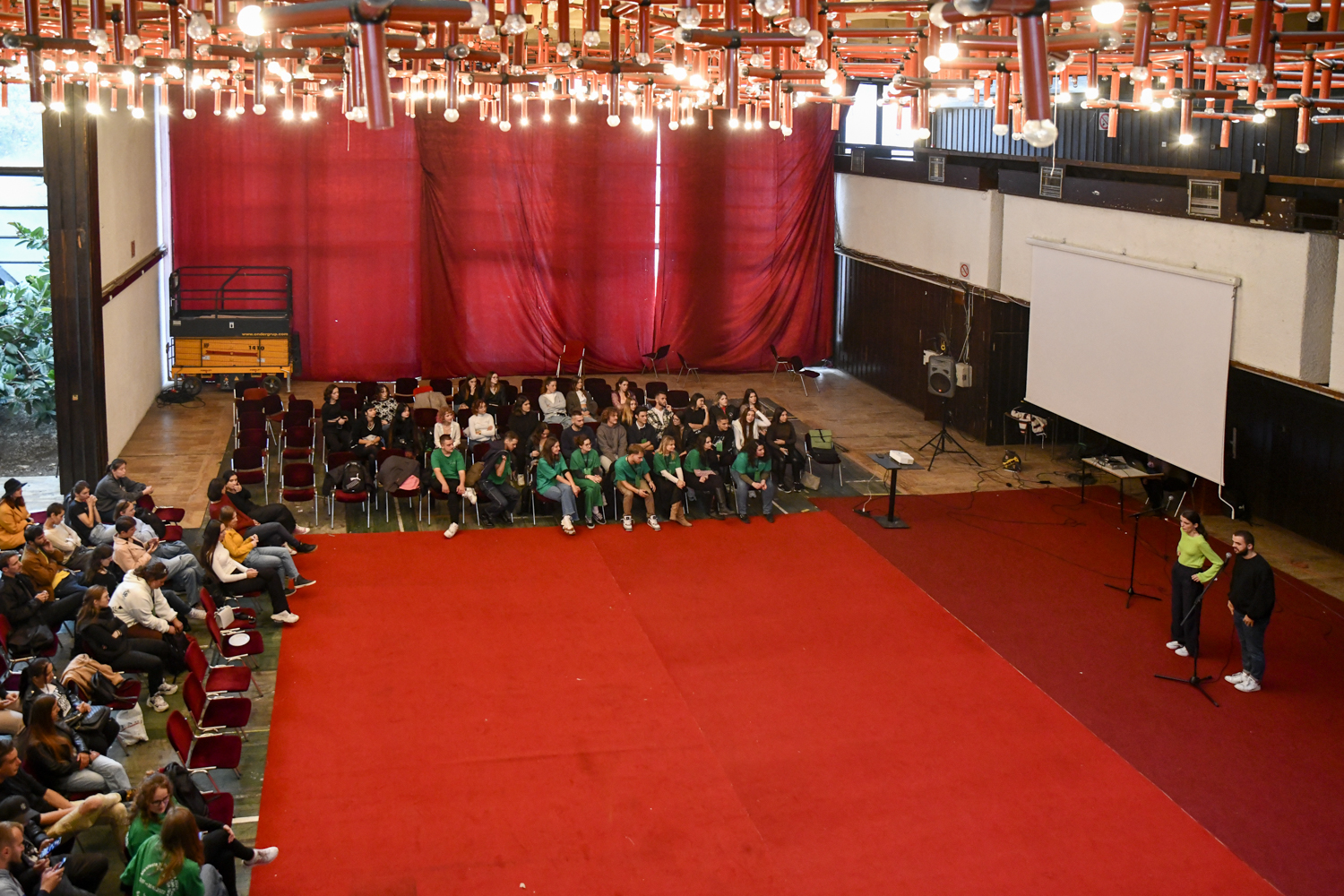
Photo: © Manifesta 14 Prishtina | Atdhe Mulla.
Sociologist and University of Prishtina lecturer Linda Gusia cited the Center for Narrative Practice as Manifesta’s “best success story,” in the way it took a derelict public space and renewed it for public use. Though she added that there should be more information available to the public for the plans about the Center’s future.
According to Manifesta, the CNP will continue its activity until at least 2027 “with a projected investment of 1 million euros” and will be the property of the Municipality of Prishtina. The Municipality did not answer K2.0’s questions about how the CNP will be financed and how it will be managed after the end of Manifesta 14.
One of the most significant and successful instances of renewing derelict public spaces in Prishtina prior to Manifesta was Termokiss. In a large abandoned structure once owned by Prishtina’s public heating company, a group of young people moved in and transformed it into a community center and event space.
Termokiss, however, does not appear on Manifesta’s green and purple map and its core members haven’t been involved in the revitalization of spaces like the CNP or the Brick Factory due to differences of opinion about what a potential collaboration would involve.
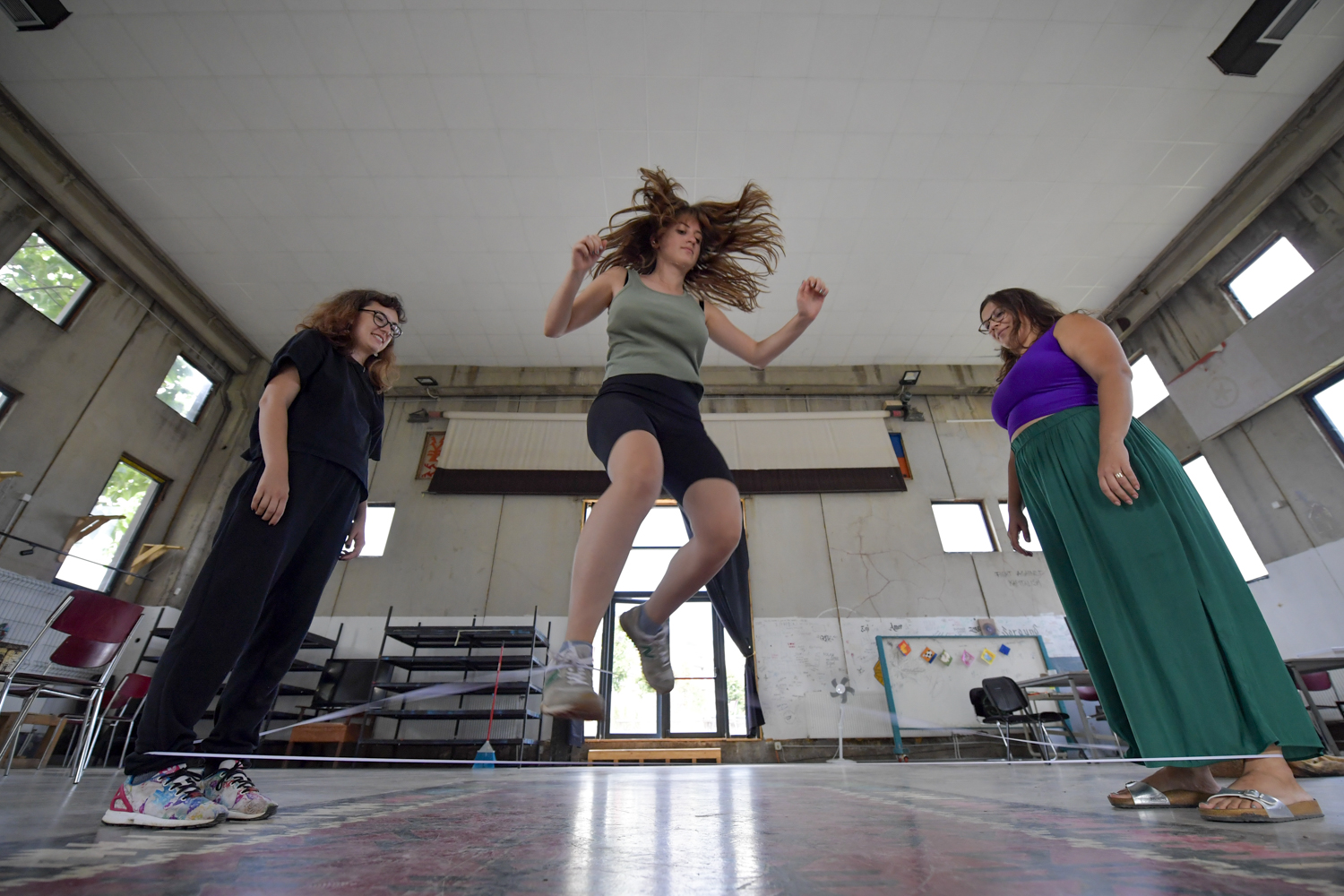
Photo: © Manifesta 14 Prishtina | Atdhe Mulla.
Nikki Murseli, an architect and an activist of the Termokiss community, has questioned the need for an entirely new center such as the CNP and said that a number of existing Prishtina cultural organizations were hoping the space would accommodate their needs for more working space and technological resources, as opposed to housing a new organization. “It was not taken into consideration during the discussion whether we need such a new center,” she said, “or whether we need more space that can be shared by existing organizations.”
Though Manifesta invited Termokiss to contribute to the revitalization of the Brick Factory, Murseli claims that Manifesta’s “approach was as if we were not a partner. When they presented the work and what they wanted to do, to me [they] sounded more like a competitor in the local scene.”
There was word that the Brick Factory would be used as a space for start-ups, technology companies and freelancers during and after the biennial. Manifesta offered the space and some budget to Innovation Centre Kosovo (ICK) to start putting the plans in motion but little ended up happening “due to weather and lack of proper internet,” according to the biennial.
Similarly, the Green Corridor appears to have fallen short of what was envisioned. Gusia suggested that what was lacking was a more meaningful engagement with the people who use the space and said that significant urban shifts cannot be achieved with short-term projects.
Murseli also had concerns about the Green Corridor. “I haven’t seen where that so-called Green Corridor actually is,” she said. “As an architect, I expected a more professional project; as a citizen, I want to know how much money from the state budget was spent there.”
Manifesta showed that with the right mobilization, the cultural sector in Kosovo can flourish. As Prishtina Mayor Përparim Rama said in an interview for Le Monde, “The city and the biennial have joined forces to achieve a transformation of the public domain.”
Rama was on the board of Manifesta 14. He was appointed prior to being elected mayor.
However, this mobilization has left some parts of the local cultural scene feeling as if “the entire state apparatus has been in service of Manifesta,” as Neziraj said, “while they do not even reply to our emails.”
What’s next?
Many praise Manifesta 14’s impact and celebrate the opportunities it has opened for Kosovo’s cultural scene. Selmani believes that Manifesta 14 “has removed the dust from the richness we have,” adding that Manifesta’s legacy should be a renewed confidence for Kosovars to “build our own story.”
But others ask what Manifesta leaves in its wake. “What is the exit plan? Will they pack all the exhibitions on the 1st of November and leave?” asked Linda Gusia. According to Manifesta 14, there is discussion that the Municipality of Prishtina and the Ministry of Culture may acquire artworks by Kosovar and regional participants of this year’s biennial, but no concrete plans have been made public.
The biennial’s organizers told K2.0 that they will publish an impact report including interviews with locals. The results will be published in the spring of 2023. A separate report looking at returns on investment and focus group data will follow.
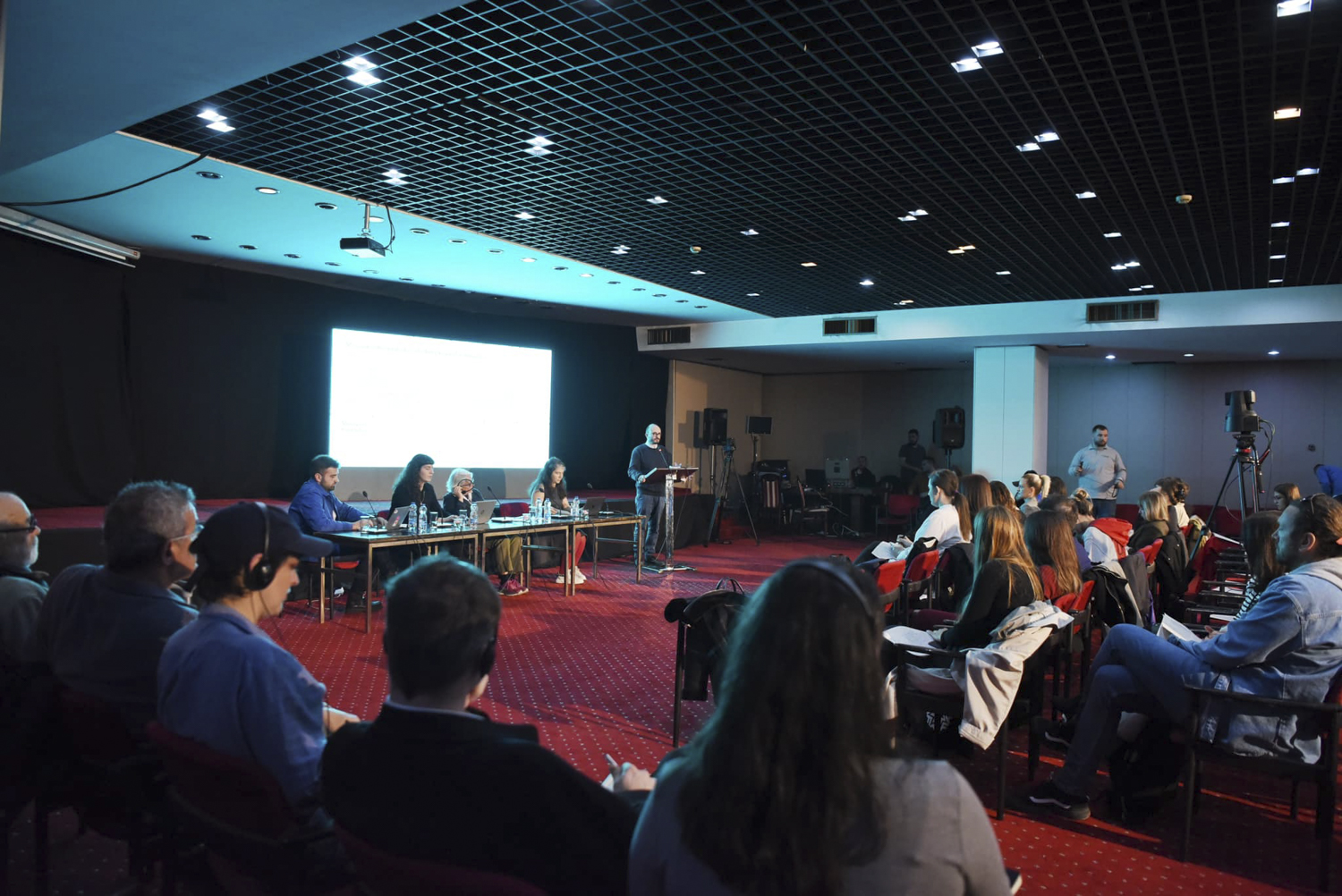
Two days before Manifesta closed, a conference was held to discuss the issue. Photo: MKRS.
During preparation for Manifesta and during the 100 days of the event, local calls for Kosovo to have its own permanent museum of contemporary art grew stronger. Proponents hope this may be one of the longer-lasting concrete results of the biennial. In May 2022, the Ministry of Culture announced plans for such a museum and Minister Hajrulla Çeku appointed an exploratory council on the topic to be led by Yll Rugova, the vice chair of Manifesta 14’s board and the head of Prishtina’s Directorate of Culture when Manifesta was invited to the city.
On October 28, two days before Manifesta 14 ended, the Ministry of Culture hosted a symposium to discuss ideas about the future museum, about which Minister Çeku said they are using Manifesta’s knowledge and experience to develop. Either the Brick Factory or Rilindja’s annex building are being considered as locations.
For now, Manifesta 14 has pledged to be a bit less nomadic than in past editions, and plans to leave behind a contingent to help run the Center for Narrative Practice. They have funding for four years, but it is not clear how exactly it will be managed or what precisely Manifesta’s role will be. The Municipality of Prishtina has declined to answer questions about the future management, ownership and budget of the Center.
After Manifesta largely leaves, it seems some buildings will be left in the derelict condition they were found in. Prishtina’s Great Hammam appears to be one such case.
In 2021 the hammam was supposed to be refurbished by TIKA and a memorandum to that effect was signed. But after TIKA requested the hammam be renamed the Fatih Hammam Museum (“fatih” meaning “conqueror”), there was public backlash about the attempt at a politicized celebration of the Ottoman conquest of the Balkans. Shortly after, the Cultural Heritage Inspectorate of the Ministry of Culture canceled the decision.
K2.0 asked the Municipality of Prishtina whether the plans to restore the hammam and convert it into a museum still stand but they have not answered. When asked about plans for the hammam, the Ministry of Culture mentioned an existing memorandum with TIKA, though the 2021 project was canceled.
While Manifesta’s legacy and the future of the cultural scene in Kosovo is unclear, the Ministry of Culture, Youth and Sport announced just a day after the biennial closed that they will be increasing their yearly budget from 39 million euros in 2022 to over 57 million in 2023. The Ministry has also said that they are “taking steps to make sure that there is a tangible and concrete legacy of Manifesta, something that will be finalized in the coming days.”
As Manifesta makes its way to Barcelona where the 15th edition will take place in 2024, one thing seems certain — with Spain not recognizing Kosovo’s independence and the onerous visa regime in place, few if any Kosovars seem likely to participate in the nomadic biennial any time soon.
Disclaimer: K2.0’s editor-in-chief Besa Luci is an unpaid member of Manifesta 14’s board. She had no role in the production of this article and was not informed of its contents prior to publication.
Feature image: Atdhe Mulla / K2.0.
The content of this article is the sole responsibility of K2.0.
Curious about how our journalism is funded? Learn more here.
